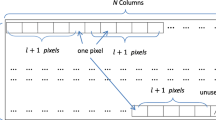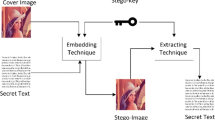Abstract
In this paper, a new histogram-based approach for digital image steganography is introduced. It stems from the idea of utilizing the near maximum values in the image histogram distribution. Conceptually, depending on whether a brightness value with the highest number of occurrence (called as maximum histogram—MH) in the histogram is even or odd, pairs of brightness values next to it are reserved for data embedding. Consequently, data hiding is realized using a pixel pair by employing the LSB technique. Essentially differing from the traditional histogram-based methods in which usually all pixels except from the MH are shifted to create a gap next to the MH of the histogram, the proposed approach does not require such a shifting and largely preserves the visual quality of the cover image. When the number of occurrences is numerically examined in the histograms, it is clear that only three brightness values, (i.e., MH, MH+1 & MH+2 or MH, MH-1 & MH-2), are trivially changed in the stego image. In addition, the MH value information is not necessarily relayed to the recipient since the histogram value of the pixels modified after embedding data is prevented from exceeding the vertex value. Throughout a detailed experimental study, the PSNR results show that the proposed approach not only increases the visual quality of stego images but also makes a reasonably high imperceptibility compared to the similar works in the literature. Considering the proposed HNMH method test results, the PSNR varies between 72.74 and 67.28 dB while the hidden data capacity can be achieved up to 12,759 Bits. The HNMH outperforms its counterparts 3 to 8 times with regard to the data hiding capacity that is almost linearly increased by means of concurrent deployment into the multiple cover image partitions up to a certain saturation point.







Similar content being viewed by others
References
Patel Z. V. & Gadhiya S. A. A survey paper on steganography and cryptography. https://oaji.net/articles/2015/1250-1430899120.pdf
Yalman, Y., Cetin, O., Erturk, I., & Akar, F. (2014). Veri Gizleme. Turkey: Beta Yayinevi.
Chrysochos, E., Fotopoulos, V., Skodras, A. N. & Xenos M. (2007). Reversible Image Watermarking Based on Histogram Modification. In 11th Panhellenic Conference on Informatics with international participation, Patras, Greece.
Gutub, A. (2010). Pixel indicator high-capacity technique for RGB image based steganography. Journal of Emerging Technologies in Web Intelligence, 2, 56–64. https://doi.org/10.4304/jetwi.2.1.56-64.
Solak, S., & Altinisik, U. (2019). Image steganography based on LSB substitution and encryption method: adaptive LSB+3. J. Electron. Imag., 28(4), 043025.
Ni, Z., Shi, Y. Q., Ansari, N., & Su, W. (2006). Reversible data hiding. IEEE Transactions on Circuits and Systems for Video Technology, 16(3), 354–362.
Meiamai, V., Minu, A., & Devi, R. A. (2013). Histogram technique with pixel indicator for high fidelity steganography. International Journal of Engineering and Technology, 5(3), 2134–2137.
Al-Husainy, M. A. F. (2015). Image steganography method preserves the histogram shape of image. European Journal of Scientific Research, 1(130), 101–106.
Xuan, G., Shi, Y. Q., Chai, P., Cui, X., Ni, Z., & Tong, X. (2007). Optimum Histogram Pair Based Image Lossless Data Embedding. Lecture Notes in Comp. Sci. (p. 5041). Berlin: Springer.
Yalman, Y., & Erturk, I. (2009). Imge Histogrami Kullanilarak Geometrik Ataklara Dayanikli Yeni Bir Veri Gizleme Teknigi Tasarimi ve Uygulamasi, XI. Akademik Bilisim Konferanslari, 1, 537–544.
Chang, C., Tai, W. L. & Chen, K. N. (2008). Lossless Data Hiding Based on Histogram Modification for Image Authentication. In IEEE/IFIP Int. Conf. on Embedded and Ubiquitous Computing (pp. 506–511).
Lin, Y. C., & Li, T. S. (2011). Reversible image data hiding using quad-tree segmentation and histogram shifting. Journal of Multimedia, 6(4), 349–358.
Kuo, W. C., Wang, C. C., & Huang, Y. C. (2015). Binary power data hiding scheme. AEU - International Journal of Electronics and Communications, 69, 1574–1581.
Hwang, J. H., Kim, J. W., & Choi, J. U. (2006). Optimum Histogram Pair Based Image Lossless Data Embedding, Lecture Notes in Comp. Sci. (Vol. 4283, pp. 348–361). Berlin: Springer.
Islamy, C. C., & Ahmad, T. (2019). Histogram-based multilayer reversible data hiding method for securing secret data. Bulletin of Electrical Engineering and Informatics, 8(3), 1128–1134.
Wu, H. T., Dugelay, J. L., & Shi, Y. Q. (2015). Reversible image data hiding with contrast enhancement. IEEE Signal Processing Letters, 22(1), 81–85.
Chen, X., Sun, H., Xiang, L., & Yang, B. (2015). Histogram shifting based reversible data hiding method using directed-prediction scheme. Multimedia and Tools Application, 74, 5747–5765.
Pan, Z., Hu, S., Ma, X., & Wang, L. (2015). Reversible data hiding based on local histogram shifting with multilayer embedding. Journal of Visual Communication and Image Representation, 31, 64–74.
Fridrich, J. (2010). Steganography in Digital Media Principles, Algorithms, and Applications. Cambridge: Cambridge University Press.
Tutuncu, K., & Demirci, B. (2018). Adaptive LSB steganography based on chaos theory and random distortion. Advances in Electrical and Computer Engineering, 18(3), 15–22.
Kurnaz, H., Konyar, M. Z., & Sondas, A. (2020). A new hybrid data hiding method based on near histograms. European Journal of Science and Technology, 18, 683–694.
Masood, F., Driss, M., Boulila, W., Ahmad, J., Rehman, S. U., Jan, S. U., & Buchanan, W. J. (2021). A lightweight chaos-based medical image encryption scheme using random shuffling and XOR operations. Wireless Personal Communications, 1–28.
Aydogan, T., & Bayilmis, C. (2017). A new efficient block matching data hiding method based on scanning order selection in medical images. Turkish Journal of Electrical Engineering and Computer Sciences, 25, 461–473.
Nassar, S. S., Ayad, N. M., Kelash, H. M., El-Sayed, H. S., El-Bendary, M. A., El-Samie, A., & Faragallah, O. S. (2016). Secure wireless image communication using LSB steganography and chaotic baker ciphering. Wireless Personal Communications, 91(3), 1023–1049.
Solak, S. (2019). Histogram-based reversible data hiding method using maximum histogram value. International Marmara Sciences Congress, 323–327.
Tai, W. L., Yeh, C. M., & Chang, C. C. (2009). Reversible data hiding based on histogram modification of pixel differences. IEEE Transactions on Circuits and Systems for Video Technology, 19(6), 906–910.
Rahman, S., Masood, F., Khan, W. U., Ullah, N., Khan, F. Q., Tsaramirsis, G., Jan, S., & Ashraf, M. (2020). A novel approach of image steganography for secure communication based on LSB substitution technique. Computers, Materials and Continua, 64(1), 31–61.
StegSpy, Web Adress: http://www.spy-hunter.com/stegspy.
Author information
Authors and Affiliations
Corresponding author
Additional information
Publisher's Note
Springer Nature remains neutral with regard to jurisdictional claims in published maps and institutional affiliations.
Rights and permissions
About this article
Cite this article
Sondas, A., Kurnaz, H. HNMH: A New Hybrid Approach Based on Near Maximum Histogram and LSB Technique for Image Steganography. Wireless Pers Commun 126, 2579–2595 (2022). https://doi.org/10.1007/s11277-022-09830-8
Accepted:
Published:
Issue Date:
DOI: https://doi.org/10.1007/s11277-022-09830-8




